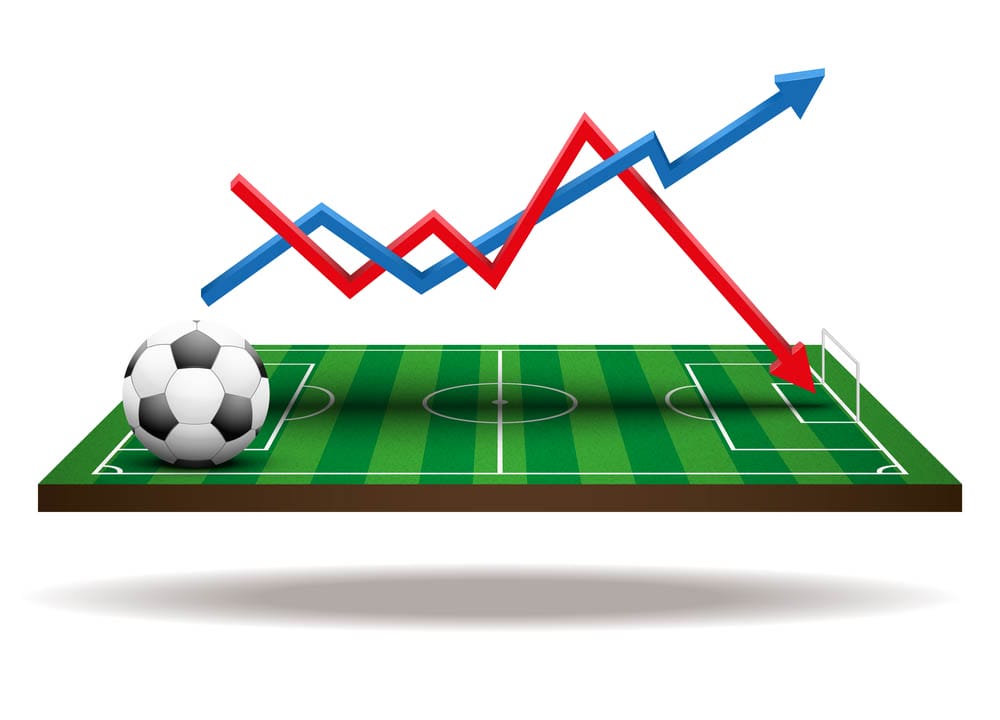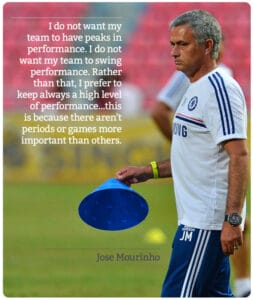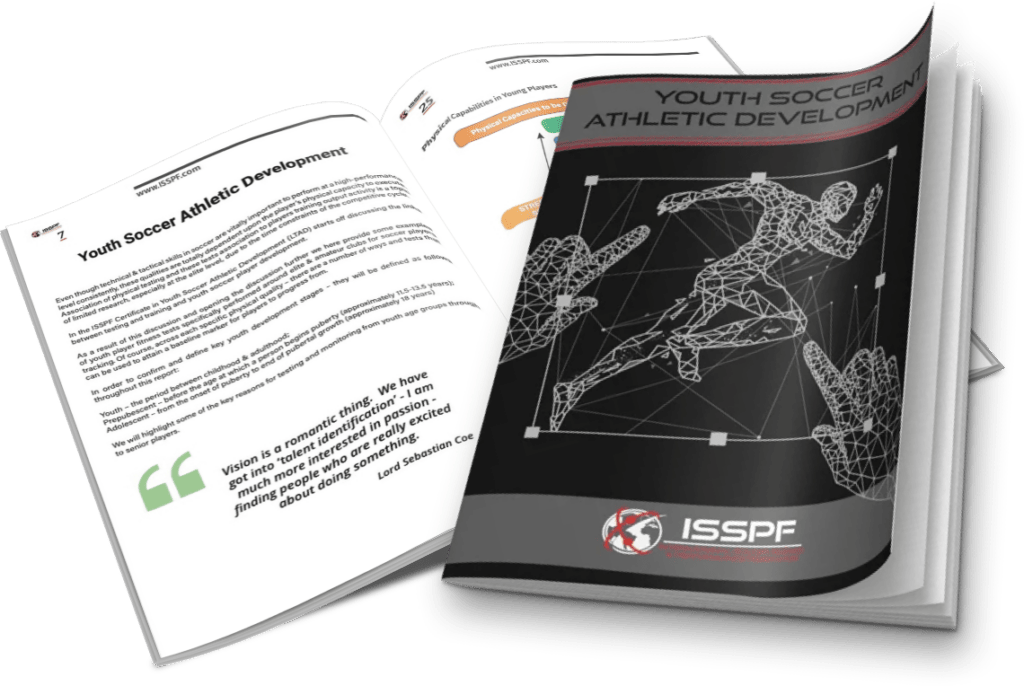Written by: Ronan Kavanagh MSc, UEFA A Licence
Training load management is a critical aspect of soccer performance, ensuring that players reach their peak potential while minimizing the risk of injuries (Bowen et al., 2017). In recent years, advanced technology and data analytics have revolutionized the way coaches and strength and conditioning experts approach training (Gabbett et al., 2016).
This article delves into the pivotal role of training load analysis in optimizing strength and conditioning in soccer, leading to better player performance and overall team success.
Understanding Training Load
The Key to Player Progression
Training load is a critical aspect of sports performance that encompasses the cumulative physical demands placed on a player during both practice sessions and actual matches. Striking the right balance in training load is paramount because insufficient workload can hinder players from reaching their full potential, while excessive load can lead to burnout and an increased risk of injuries (Gabbett et al., 2012). To effectively manage training load and minimize the risk of overtraining and injuries, load monitoring has become increasingly sophisticated in soccer.
Advancements in technology, such as cutting-edge wearable devices and tracking systems, have revolutionized the way load monitoring is conducted (Taberner et al., 2019). These advancements include the use of GPS trackers, heart rate monitors, and accelerometers, which gather real-time data on various aspects of players’ performance during training sessions and matches.
With the help of GPS trackers, coaches can precisely monitor players’ movements and positioning on the field. This technology allows them to analyze running distances covered by each player, assess their speed, and identify patterns in their positioning and movements during different phases of the game.
This information is invaluable in understanding player workload and optimizing training programs to target specific areas for improvement.
Heart rate monitors offer insights into players’ physiological responses during training and matches. By monitoring heart rate variations, coaches can gauge players’ cardiovascular fitness and exertion levels. This data helps in determining if the intensity of training sessions aligns with the desired objectives and if players are adequately recovering between sessions.
Accelerometers provide data on the acceleration and deceleration patterns of players. This information is essential for evaluating explosive movements and changes of direction, which are critical aspects of soccer performance.
Coaches can use this data to assess players’ agility and speed capabilities, helping them tailor training sessions to enhance these attributes. The wealth of data collected from these advanced wearable devices and tracking systems offers coaches a comprehensive overview of each player’s workload.
Armed with these insights, coaches can make informed, data-driven decisions to optimize training programs for individual players or the entire team. They can identify players who may be at risk of overtraining and adjust their training loads accordingly. Simultaneously, they can design personalized training plans to address specific areas of improvement for each player.
In summary, training load refers to the cumulative physical demands placed on players during practices and matches. The advancement of wearable devices and tracking systems, such as GPS trackers, heart rate monitors, and accelerometers, has significantly improved load monitoring in soccer.
This real-time data provides coaches with valuable insights into players’ performance, workload, and physiological responses, enabling them to make data-driven decisions to optimize training programs and reduce the risk of overtraining and injuries. By striking the right balance in training load, coaches can help players perform at their best and minimize the risk of burnout and setbacks.
Training Load Management Course
Enhancing Strength and Conditioning Strategies
Individualized Training Programs
The ability to analyze training data at an individual level is a game-changer in soccer. Not all players have the same physical capabilities or endurance levels, and a one-size-fits-all approach to training may not be optimal (Kavanagh & Carling, 2012).
Training load analysis enables coaches to tailor training programs based on individual player characteristics, injury history, and performance goals. By assessing each player’s fitness levels, load tolerance and recovery capacity, coaches can design personalized training sessions that challenge players appropriately while avoiding overexertion.
This approach not only enhances performance but also reduces the risk of injuries, ensuring players stay fit and available for selection throughout the season (Kavanagh & Carling, 2012). Tracking and analyzing changes in training patterns and performance metrics over time enable coaches to recognize signs of fatigue or declining performance. By acting on this data, they can modify training regimens, offer adequate recovery periods, which can help to optimise performance and reduce injury risk.
Injury Prevention
Injuries are an inevitable part of any sport, but with effective training load management, their occurrence can be minimized. By analyzing training data, strength and conditioning experts can identify periods of increased injury risk and adjust training loads accordingly.
For example, if a player’s data suggests they are at increased risk of muscle fatigue or injury, coaches can reduce their training intensity or incorporate recovery sessions to mitigate risk. Likewise, players returning from injuries can be carefully monitored using load analysis to ensure they progress safely through their rehabilitation programs. Indeed high levels of aerobic fitness have been shown to protect against injury risk (Malone et al., 2017).
Optimizing Performance
Training load management is a crucial aspect of sports coaching and performance optimization, with its ultimate objective being to enhance the performance of athletes on match days. The process involves fine-tuning training programs using data-driven insights and analysis to ensure that players reach their peak performance levels at the most critical points of the season.
Data-driven insights are obtained through the collection and analysis of various performance metrics, such as physical exertion, recovery rates, and injury data, among others.
By utilizing this valuable information, coaches can make informed decisions on how to structure and adjust training regimens for individual athletes or the entire team.
This approach ensures that players are physically and mentally prepared to deliver their best performances during important matches.
A key aspect of load management is load analysis, which involves identifying periods when training demands are particularly high. This could occur during congested fixture schedules, where players have to participate in multiple matches within a short timeframe.
Understanding these challenging periods allows coaches to plan training sessions strategically. They can adjust the training loads to strike a balance between pushing players to improve their fitness and skills while also allowing sufficient time for rest and recovery to prevent overtraining and injuries.
Periodization techniques play a significant role in load management. Coaches implement periodization by dividing the season into specific phases, each with distinct training goals. For example, the preseason phase may focus on building overall fitness and strength, while the in-season phase might concentrate on maintaining peak performance and tactical skills.
By modifying training loads and exercises according to these different phases, coaches can optimize the players’ physical condition at various points during the season.
The work cited in the text, by Palucci et al. (2019), likely emphasizes the importance of evidence-based load management strategies. Such studies are crucial for advancing the field of sports science and coaching, as they provide valuable insights into the best practices for optimizing player performance and reducing the risk of injuries.
Balancing Performance and Player Well-being
By optimizing performance through data-driven training strategies, teams can aim for sustained success throughout the season (Colby et al., 2018).
Moreover, training load analysis not only enhances player performance but also promotes their well-being.
Striking the right balance between training intensity, recovery, and periodization ensures players remain at their peak physical condition while reducing the risk of burnout and injuries. As technology continues to advance, training load management will evolve, providing even more precise insights into player performance and recovery.
Embracing data-driven training methodologies will remain a pivotal component of soccer’s journey towards excellence, elevating the beautiful game to new heights of success and player well-being.
Join the ISSPF Course in Training Load Management for Soccer
In the world of soccer, Training Load Management has emerged as one of the most hotly debated topics, with coaches and managers recognizing the importance of squad rotation for achieving both fitness and freshness benefits. To succeed in this approach, it is crucial to consider individual players’ fitness levels, injury history, age, and physiology when managing game and training loads.
As the demand for training load management experts and coaching specialists in football continues to grow, you might wonder what your next step should be. How can you specialize in this area? Which specific field within sport science do you want to delve deeper into? These questions are indeed intriguing, especially when transitioning from completing a sport science degree to working in professional football and trying to grasp all the key components and soft skills that come with jobs in football or careers within the sports industry.
Fortunately, the ISSPF Elite Faculty members have designed bespoke courses to provide sport science students, professionals working within the game, coaches, physiotherapists, doctors, sports therapists, and other football science enthusiasts an opportunity to further develop their expertise in this field.
One such course is the ISSPF endorsed and accredited Training Load Management online sport science course, tailored specifically for soccer. This course will expose you to football science and specific soccer coaching-led research, practical examples, and training load monitoring methods employed by leading practitioners in various levels of team sports development.
Why is this Course Important?
- It highlights the reasons for monitoring and assessing training load in soccer.
- It emphasizes the practical application of modern training load monitoring and assessment tools.
- It provides an understanding of the importance of monitoring players’ training load and minimizing training ‘spikes.’
- It helps you comprehend the delicate balance between soccer-related fitness, freshness, and fatigue.
- It assists in preparing players for the physical, technical, and tactical demands in a safe and progressive manner.
- It may help reduce the risk of non-contact muscle injuries by offering better insights into planning and preparation.
Who is this Course for?
- Individuals responsible for training and coaching athletes or team sports.
- Individuals interested in enhancing their knowledge in the training and development of individual athletes or team sports.
Course Information
- Average Workload: 20 hours total (pre-lecture reading + online content + questions + assignment)
- Delivery Method: Online-based
- Language Delivered: English
Take the next step in your soccer coaching and sport science journey by enrolling in the ISSPF Soccer Training Load Management Course now.
Training Load Management Course
Course Outline
Training Load Management course:
Module 1: Soccer player testing & monitoring: Real evidence
Lecturer: Prof. Darren Paul (England)
Module 2: Injury reduction strategies in professional soccer
Lecturer: Dr. Patrick Orme (Bristol City FC)
Module 3: Considerations & Applications of Training Load Monitoring in Elite Soccer Players
Lecturer: Dr. Vasilis Kalapthorakos (Panathinikos, Greece)
Module 4: Soccer specific monitoring: Weekly microcycle, planning and performance
Lecturer: Dr. Dawid Golinski (Slask Wrowclaw, Poland)
Module 5: External load monitoring in professional soccer: Understanding GPS tracking
Lecturer: Dr. Xinji Xi (Catapult, China)
Module 6: Testing and monitoring in soccer: training & games
Lecturer: Dr. Berni Guerro (CF Malaga, Spain)
Topic: Performance Analysis
Module 7: Soccer specific monitoring: Subjective effort assessment
Lecturer: Dr. Dawid Golinski (Slask Wroclaw, Poland)
Module 8: Training Load Management: The appliance of science
Lecturer: Dr. Adam Owen (England FA, Lech Poznan)
References (click + to expand)
REFERENCES:
- Bowen L, Gross AS, Gimpel M, Li F-X. Accumulated workloads and the acute: chronic workload ratio relate to injury risk in elite youth football players. Br J Sports Med. 2017;51(5):452-459.
- Gabbett TJ, Kennelly S, Sheehan J, et al. If overuse injury is a ‘training load error’, should undertraining be viewed the same way? Br J Sports Med. Sep 2016;50(17):1017-8. doi:10.1136/bjsports-2016-096308
- Gabbett TJ, Ullah S, Finch CF. Identifying risk factors for contact injury in professional rugby league players–application of a frailty model for recurrent injury. J Sci Med Sport. Nov 2012;15(6):496-504. doi:10.1016/j.jsams.2012.03.017
- Taberner M, O’Keefe J, Flower D, et al. Interchangeability of position tracking technologies; can we merge the data? Sci Med Footb. 2019;4(1):76-81. doi:10.1080/24733938.2019.1634279
- Kavanagh R, Carling C. Analysis of external workload in soccer training and competition: generic versus individually determined speed thresholds. Sci Med Footb. 2019;3(1):83-84.
- Malone S, Roe M, Doran DA, Gabbett TJ, Collins K. High chronic training loads and exposure to bouts of maximal velocity running reduce injury risk in elite Gaelic football. J Sci Med Sport. 2017;20(3):250-254.
- Palucci Vieira LH, Carling C, Barbieri FA, Aquino R, Santiago PRP. Match Running Performance in Young Soccer Players: A Systematic Review. Sports Med. Feb 2019;49(2):289-318. doi:10.1007/s40279-018-01048-8
- Colby MJ, Dawson B, Peeling P, et al. Improvement of Prediction of Noncontact Injury in Elite Australian Footballers With Repeated Exposure to Established High-Risk Workload Scenarios. Int J Sports Physiol Perform. Oct 1 2018;13(9):1130-1135. doi:10.1123/ijspp.2017-0696
Share this article:











